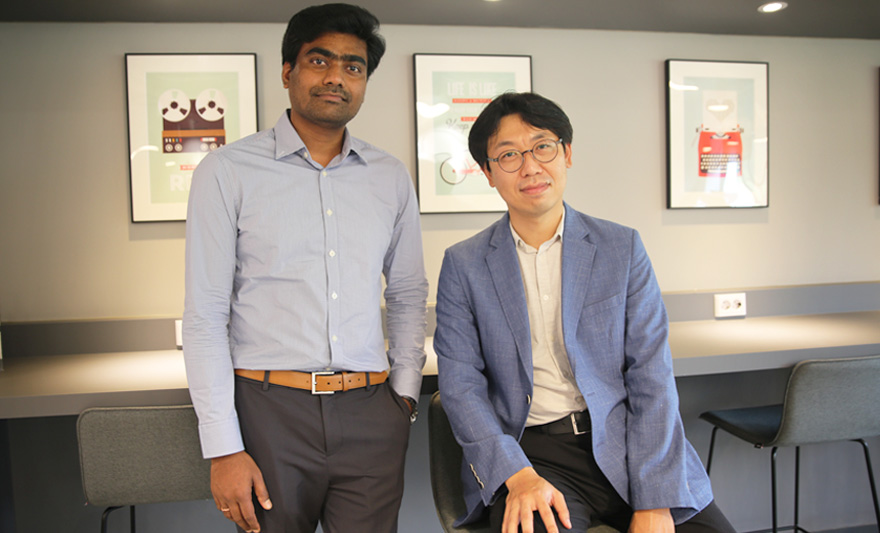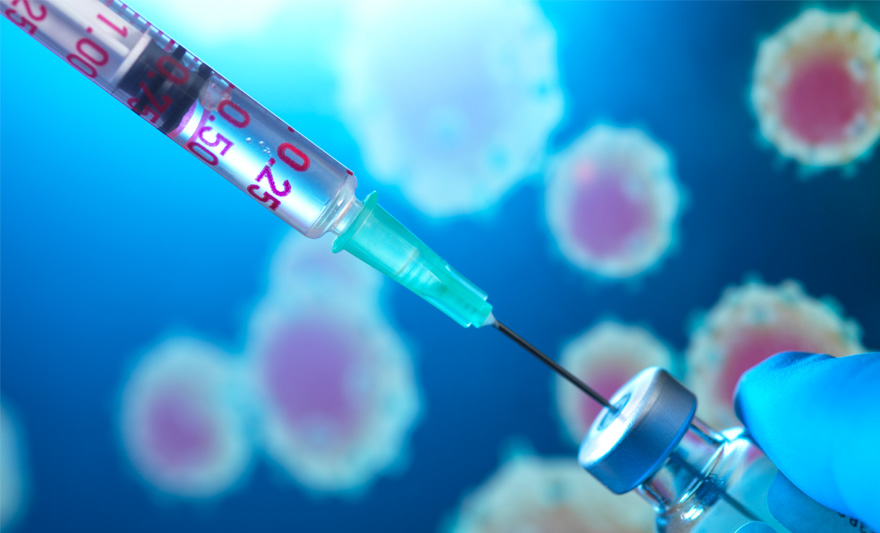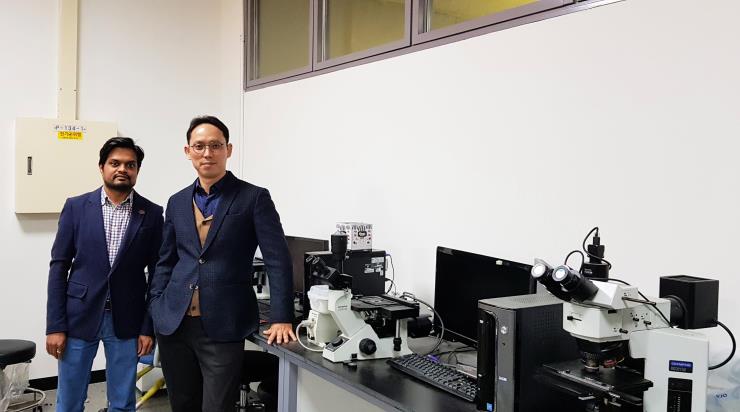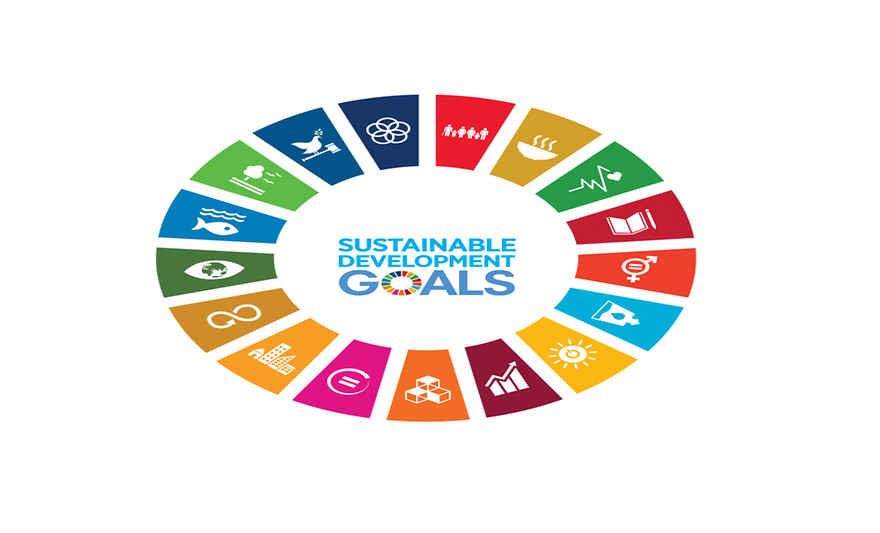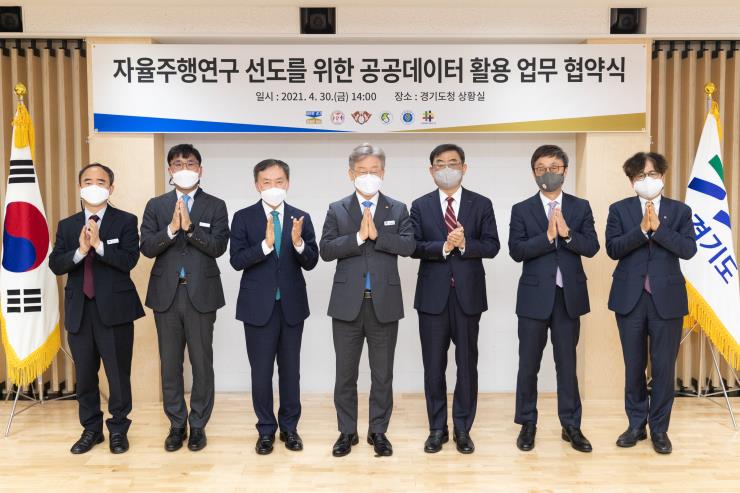-
Professor Lee Jung-ho’s Team from Ajou University’s Department of Mechanical Engineering has been selected as a lead research team for the 1st Energy Technology Development Project launched in 2021 by the Ministry of Trade, Industry and Energy (MOTIE). The MOTIE is leading around 80 projects in the fields of new and renewable energy, energy-related new industry, clean thermal and nuclear power plant, smart grid, and public R&D in order to realize a carbon neutral society and promote technology development for Green New Deal projects that will enable the country to respond to changes in energy environment. A total of KRW 195 billion will be shared amongst 119 projects. Professor Lee Jung-ho (left in photo) has been selected to lead a project on core technology and module development to improve the performance of heat pipe heat exchangers using a boiling model, which Lee’s team applied for within the category of “Projects related to technology development for energy demand management.” The project timeline is from May 2021 to December 2025 and is projected to cost KRW 13.5 billion.A heat exchanger transfers heat from a region of higher temperature to one of lower temperature through a heat pipe—a very high thermal conductance device which does not consume any external energy. The device structure is simple and is not easily deformed by heat, lending it to use as a heat exchanger for recovery of waste heat and cooling/heat exchange systems in the aerospace industry.Professor Lee Jung-ho’s team (right in photo) plans to develop a boiling pipe heat exchanger. A boiling pipe uses ‘boiling’ heat transfer technology which surpasses the performance of existing heat exchangers, dependent as they are on evaporation. The new heat transfer technology is gaining a lot of traction as a core technology for advanced management of heat from high heat sources such as cooling devices for power semiconductors, electric vehicles, energy storage systems (ESSs) and laser-guided munitions.The team aims to contribute to reducing greenhouse gas emissions and lower energy costs of power plants, boilers, incinerators, etc. It expects to add value by cutting the indirect energy waste in waste heat recovery by small and medium-sized companies.Lee Jung-ho, who heads the project, was appointed in March 2021 as professor in the Department of Mechanical Engineering. He is one of the top Korean experts in advanced insulation and heat management technology, and has developed heat system insulation technology and heat management technology over the past 25 years.Leading institutions participating in this project led by Ajou University include Korea Institute of Machinery and Materials, Chungang University Industry Academic Cooperation Foundation, Ulsan National Institute of Science and Technology (UNIST), Korea Advanced Institute for Science and Technology (KAIST), and Uniwel Corporation.<Overview of a Boiling Pipe Heat Exchanger>히트파이프(증발/막응축)Heat Pipe (Evaporation/Filmwise Condensation)비등파이프(비등/적응축): 상변화 열전달 촉진Boiling Pipe (Boiling/Dropwise Condensation): Enhancing phase change heat transfer히트파이프: 파이프 내부 증발과 막응축을 이용한 열교환Heat Pipe: Heat exchange through evaporation and filmwise condensation inside pipe비등파이트: 파이프 내부 비등과 적응축을 이용한 열교환Boiling Pipe: Heat exchange through boiling and dropwise condensation inside pipe열교환기 효율 양상에 따른 Compact 구현Creating a compact module by enhancing heat exchanger efficiency
-
514
- 작성자OIA
- 작성일2021-08-03
- 5693
- 동영상동영상
-
Ajou University is set to embark on an extended reality (XR) project after successfully winning the “2021 XR Lab Project” co-hosted by the Ministry of Science and ICT (MSIT) and the Korea Radio Promotion Association (RAPA).The project aims to advance the field of XR, which includes virtual reality, augmented reality and mixed reality, and develop professionals by supporting their research, start-up activities and technology commercialization of XR content and services. The selected research teams will be granted KRW 1.18 billion over the next 3 years toconduct their project.As part of the project, the Ajou University team, led by chief researcher and professor Seok Hye-jung (Department of Digital Media) and consisting of professors Teemu H. Laine, Oh Kyu-hwan, Chang Woo-jin and Kim Eun-ha (Department of Psychology), professor Kim Tae-sun (Department of Education, counselling major), and professor Jung Tae-sun (Department of Software), will establish a VHEX lab (Virtual Human Experience Lab) together with doctoral, master’s and undergraduate students.The research team will develop VR content and a platform that enable diagnosis of empathetic patterns in adolescents and provide training. The team aims to create lively, well-organized content that harmoniously converges virtual reality and physical reality using VR, AR and other ICT technologies, thereby attracting young people to participate more actively in diagnosis and training. The ultimate goal of the empathetic pattern diagnosis and training is to reduce social issues including bullying and ostracizing others at schools and help teenagers have a more balanced perspective and empathetic abilities.The Ajou research team intends to commercialize the VR platform and will also execute training programs for psychology professionals working in Fourth Industrial Revolution (4IR) fields.The Life Media interdisciplinary program of Ajou Graduate School has been leading various joint research projects to develop Well-Life content centering around positive psychology and ICT technology.The MSIT and RAPA have selected 6 new XR labs, including the Ajou lab, this year. The selected labs will receive a variety of support including research grants, consulting services for commercialization, expert seminars, opportunities to participate in exhibitions, and promotion of research outcomes.<Overview of XR Content Platform for Empathetic Patterns Diagnosis and Training for Each Type>공감유형진단VREmpathetic Patterns Diagnostic VR[인지-감정, 긍정-부정, 소수-다수] + 공감 표현 수준 측정[Awareness-Emotion, Positive-Negative, Minority-Majority] + Measure level of empathetic expressions인공지능 가상 캐릭터와 상황 시나리오Virtual AI character and event scenario상호작용 응답 생체 센서Interactive/responsive biosensors공감 유형 진단 결과Empathetic patterns diagnosis result공감교육VREmpathy Training VR편향된 공감의 밸런스를 맞추기 위한 공감 교육 액티비티Empathy training activities to rebalance one’s biased empathy 공감 유형별 공감 교육 추천Empathy training recommendation by each empathy type롤플레잉 게이미피케이션Role-playing gamification상호작용 액티비티Interactive activities
-
512
- 작성자OIA
- 작성일2021-08-03
- 5144
- 동영상동영상
-
Photo Essay & Video Contest: Life at Ajou 2021 was held with the participation of foreign students enrolled at Ajou University. Participants submitted photos and videos featuring their favorite places, classes, friends, etc. at Ajou. Hosted by the International Exchange and Cooperation Team on May 15, the awards ceremony was split into two sessions: the awards ceremony itself and presentations on the prize-winning photos and videos. Undergraduate, graduate, and exchange students from France, Germany, Bangladesh, and other nations took part in the contest, showing their interest in and affection towards Ajou. In the photo category, Leonardo from Germany ranked first. He featured cherry blossoms on the campus of Ajou and Gaon Garden, where students frequently meet up.Meanwhile, Babatobi from Nigeria and Leonardo from Germany won first place in the video category. The duo’s video covered the friendships built with Ajou students from around the world. The award-winning photos and videos will be used for international promotions by the Ajou University Office of International Affairs. Ajou University has sisterhood relationships with 320 universities and institutions in 67 countries around the world. A variety of programs are now underway with these universities, including student and faculty exchanges, dual degrees, and joint studies. Some 1,100 foreign students from undergraduate, graduate, and exchange programs are currently enrolled at Ajou. Despite the COVID-19 crisis, around 140 exchange students have been studying at Ajou during the first semester of 2021.
-
510
- 작성자OIA
- 작성일2021-07-01
- 6077
- 동영상동영상
-
A team of researchers led by Prof. Kim Sung-hwan, from the Departments of Physics and Energy Systems Research, has developed electronic skin capable of generating energy with a touch using silk protein nanofibers. This development is expected to be used as a next-generation bio-electronic material, generating electric energy or acting as sensory organs upon attachment to the human skin or soft robots. Prof. Kim announced successful development of electronic tattoos, which make it possible to draw circuits on silk protein nanofibers with carbon nanofiber ink using electrostatic-harvesting materials. Protein derived from silkworms is a skin-friendly, high-molecular biomaterial. The achievement was published online under the title, “Self-powered and Imperceptible Electronic Tattoos based on Silk Protein Nanofiber and Carbon Nanotubes for Human-machine Interfaces,” in Advanced Energy Materials (Impact Factor 25.245), a prestigious international journal covering energy materials, on May 11. Prof. Narendar Gogurla, Research Assistant Professor, participated as first author and worked together with Prof. Kim. There is a fast-growing body of research worldwide on materials for next-generation electronic healthcare devices for human-machine interfacing. Electrostatic-harvesting materials that leverage electrostaticity as an energy source are gaining more traction than ever. Electrostatic-harvesting materials can be used as a source of energy to move healthcare materials and artificial sensing organs that relay information related to human body movements. However, in order to increase energy efficiency, compatible materials should be used (e.g. hair and plastic show ideal electrostaticity), serving as an obstacle to generating electric energy in direct contact with human skin. In addition, the fact that the materials should be attached to human skin, no matter how uneven, while being composed of elements harmless to the human body, makes it harder to accelerate outcomes for research on electrostatic-harvesting materials. The team focused on silk proteins available from natural sources. Protein derived from silkworms is a skin-friendly, high-molecular biomaterial with superior physical and chemical properties. In the first step, the researchers make silk nanofiber paper, of a thickness equivalent to one-fiftieth of a strand of human hair, using electrospinning. Afterwards, they draw circuits on the silk nanofiber paper using carbon nanofiber ink and brush. Once the ink dries, the drawn circuits come out. Placing the circuits on slightly moist skin creates the electronic tattoo.The electronic tattoo is ultrathin, so it can be put on finely-wrinkled skin surfaces like finger pads while maintaining stability of its electric properties during everyday activities, besides taking showers. Electronic tattoos can easily be wiped off with wet wipes. Materials derived from silk nanofibers are harmless as the silk nanofibers are injected in the middle of the electronic tattoos.Interestingly, electronic tattoos attached to the human skin have the highest efficiency, signifying that other materials, including disposable gloves, should be worn to increase the efficiency of electrostatic energy. The harvested electric energy is sufficient to operate small electronic devices, such as LEDs and stopwatches. The fact that electric signals are generated with a single touch means that the tattoos can be used as artificial sensing organs. The team successfully drew pixel tattoos on the skin, proving that drawn circuits are capable of being converted into electric signals with the touch of a finger. Prof. Kim explained: “Although there has been significant progress in research on harvesting energy from the human body, the problems related to human-machine interfacing have been relatively neglected. Using proteins, of which natural skin is composed, interfaces capable of bridging the material difference between the human body and electronic devices can be developed.”He also added: “Our project is significant in that our invention can help increase the application of biomaterials to a variety of electronic devices. We hope to see our product applied to a wide range of healthcare products and soft robotics in the future.”The research was sponsored by the Rural Development Administration, the National Research Foundation of Korea, the BK21 FOUR, and the Gyeonggi-do Regional Research Center.Description: (Left) A conceptual diagram of a silk, electrostatic electronic tattoo, able to collect electric energy with a single touch on the skin using biocompatible electronic tattoos. (Right) An experiment on artificial sensing organs. Circuits drawn as pixel tattoos on the skin are capable of being converted into electric signals with the touch of a finger.
-
508
- 작성자OIA
- 작성일2021-07-01
- 6177
- 동영상동영상
-
세계순위World Rankings국내순위Domestic RankingsAjou University has risen in the QS World University Rankings for three consecutive years. Quacquarelli Symonds (QS), based in the UK and the world’s largest international higher education network, announced the rankings for 1,300 of 6,415 universities around the world this year. In the QS World University Rankings, which were announced on May 9, Ajou University ranked in the 531-540 range. Ajou University ranked in the 651~700 range in 2018, the 601-650 range in 2019, and the 551-560 range in 2020. Its 2021 placement in the 531-540 range mark a jump of 20 ranks. It was ranked 13th among domestic universities. It was a remarkable achievement for Ajou University, especially as 16 of the 20 participating domestic universities were ranked lower in 2021 than they were last year. A rise in the scores for academic reputation, graduates, and education is driving the constant increase in rankings. Ajou University has been making meaningful efforts to acquire talented faculty and improve research quality and impact. To better evaluate quality of research, the Thesis Excellence Award has been launched while research funding for new and junior faculty have increased. A maximum of KRW 100 million in research funding will be granted to the sciences and engineering and KRW 50 million to the humanities and social sciences.Furthermore, research funds specifically for post doctorate researchers will be allocated and well-known scholars are to be invited through the hosting of international academic conferences. In addition, Ajou University has created a “Paran Semester,” which enables students to carry out challenging academic projects that they design themselves throughout the entire semester, including extracurricular activities, organized field trips, and start-up accelerator programs. In this way and others, Ajou has been working to help students develop problem-solving skills, which are a prerequisite for most jobs in the future. QS announces the world university rankings every year. Universities are evaluated by six key ranking indicators in the four categories of research, environment, globalization, and reputation. The highest weighting (40%) is allotted to each institution’s Academic Reputation score, which is derived from the opinions of over 130,000 experts in the higher education space. The Employer Reputation metric (10%) is based on over 75,000 responses from employers who participate in the QS Employer Survey. Included in the evaluations are Faculty/Student Ratio (20%), International Faculty Ratio/International Student Ratio (5% each), and Citations per Faculty across a five-year period (20%). In this year’s QS World University Rankings, MIT ranked first, followed by the University of Oxford, the University of Cambridge, and Stanford University. As for domestic universities, Seoul National University (36th), KAIST (41st), Korea University (74th), Yonsei University (79th), and Pohang University of Science and Technology (POSTECH) (81st) were included in the top 100 universities in the world. Meanwhile, Ajou University has been receiving greater recognition from authoritative institutions of academic ranking of global universities. Ajou University also ranked 130th, jumping 49 ranks from last year, in the Times Higher Education (THE) Asia University Rankings 2021, which were announced on May 2. This April, in the Impact Rankings 2021 by THE, Ajou University ranked in the 201-300 range, rising more than 100 ranks from 2020, for the industry and innovative infrastructure sector (SDG9).<Percentile Evolution in QS World University Rankings of Ajou University: Ajou University is rising constantly upward even while the number of global universities participating in QS World University Rankings increases.><Results of THE Asia University Rankings 2021: The table above indicates changes in Ajou University’s global and domestic rankings. The table below indicates percentile evolution of Ajou University in THE Asia University Rankings.>#See the results of the QS World University Rankings 2022
-
506
- 작성자OIA
- 작성일2021-07-01
- 7830
- 동영상동영상
-
A ground-breaking ceremony for Hyegang Hall, a new laboratory building, was held on May 8. The Hall, a seven-story building with two basement floors, is set to be completed by August 2022. The ceremony was held with the attendance of officials from the Daewoo Educational Foundation and Ajou University, including Mr. Choo Ho-seok, Chairman of the Daewoo Educational Foundation, Mr. Kim Sun-yong, Permanent Director of the Daewoo Educational Foundation, Dr. Park Hyung-ju, President of Ajou University, and other prominent officials at Ajou. It was also attended by Prof. Na Sang-sin, Mr. Cho Jae-hyun, University Labor Union Leader, Mr. Kim Hyun-bin, President of the Student Council, Mr. Ahn Chang-joon President of the General Alumni Association, and related officials from the construction and architectural firm. Mr. Kim Yong-deok, Head of Yeongtong-gu Office, participated to represent the city of Suwon as well. Hyegang Hall, with a total area of 13,223 square meters (4,000 pyeong), will be built behind Dasan Hall and the Collage of Pharmacy Building. The first and second floors will be used for academic-industrial cooperation, while the third to the seventh floors will be designed for research. “Hyegang” was the pen name of Choi Han-ki, a silhak (practical science) scholar and a natural science thinker during the Joseon Dynasty. Based on his deep understanding of Western natural sciences in convergence with the traditional theory of energy in Korea, he was able to pave the way for new philosophical thinking. He was also the author of “Singicheonheom,” one of the classics that demonstrate the way in which Western medicine was introduced to Korea during the later years of the Joseon Dynasty. Last November, a groundbreaking ceremony was held for Ilsin Hall, an 11-story dormitory with one basement floor. With a total area of 14,680 square meters (4,441 pyeong) to accommodate up to 804 people, it is scheduled to be finished by February next year.
-
504
- 작성자OIA
- 작성일2021-07-01
- 6686
- 동영상동영상
-
The Graduate School of International Studies (GSIS) at Ajou University held an event entitled, “Share Your Country Report.” During the event, students taking the KOICA-Ajou Scholarship Program for Master's Degree gave presentations. Held on May 2 at Yulgok Hall, Prof. Kim Byoung-kwan, Dean of Ajou GSIS, Prof. Kim Su-duk from the Energy Systems Division, and Prof. Jung Jae-sung, Associate Professor from the Department of Electrical and Computer Engineering, as well as 20 foreign students from 17 countries attended. The participating students are in the KOICA-Ajou Scholarship Program for Master's Degree, which is part of KOICA’s leadership program for young and mid-level leaders of civil society in Korea’s partner countries. Using the academic knowledge gained during the scholarship program, the participants presented and shared the current status of energy and some pending issues in their nations.Graduate-level education, particularly in the areas of energy self-sufficiency, reinvention of the energy industry, renewable energy growth, climate change, energy education, etc., has been provided by Ajou GSIS. Ajou GSIS consists of five departments: International Business, International Trade, NGO Studies, International Development and Cooperation, and Energy Studies. The KOICA-Ajou Scholarship Program for Master's Degree was established towards achieving the UN Sustainable Development Goals (SDGs) by providing quality education, facilitating economic growth, preventing climate crisis, and forging partnerships.
-
502
- 작성자OIA
- 작성일2021-07-01
- 6360
- 동영상동영상
-
A team of researchers led by Prof. Prof. Choi Sang-dun (from the Departments of Biological Sciences and Molecular Science & Technology) at Ajou University, announced the results of its study on drugs that are effective in preventing COVID-19. Prof. Choi (pictured), Prof. Kim Moon-suk (from the Departments of Applied Chemistry & Biological Engineering and Molecular Science & Technology), and S&K Therapeutics studied a number of anti-COVID-19 drugs approved by the US Food & Drug Administration and found that Remdesivir and Ledipasvir have potential to inhibit SARS-CoV-2 replication. S&K Therapeutics is a drug developer for autoimmune diseases, viral diseases, etc., and was established by Prof. Choi. The research findings were published in Cells, a prestigious international journal, under the title, “Remdesivir and Ledipasvir among the FDA-Approved Antiviral Drugs Have Potential to Inhibit SARS-CoV-2 Replication,” in April. Coronaviruses are positive-strand RNA viruses with a relatively larger virus genome. A genome is all genetic material of an organism, consisting of DNA or RNA. The coronavirus genome RNA is encapsulated by the nucleocapsid protein and polyadenylated with the spike glycoprotein on the viral envelope. The currently-developed COVID-19 vaccines especially target the spike glycoprotein.The team is currently developing materials that fight RNA-dependent RNA polymerase (RdRp). RdRp has a low probability of transformation, being the perfect target to control the reproduction of RNA viruses. The team, in an effort to respond in a timely manner to the rapid spread of COVID-19 and a surge in infections and deaths, focused on anti-coronavirus drugs approved by the FDA. Ajou University and S&K Therapeutics conducted an in silico screening of hundreds of antiviral drugs approved by the FDA through virtual screening first. In silico screening uses screening tools to make predictions about the behavior of different compounds. The team selected the first batch of drugs based on a series of simulations on anti-virus drugs and RdRp, and then identified the antiviral activities of SARS-CoV-2 in Vero E6 cells. As a result, Remdesivir and Ledipasvir were proven to be most effective. Vero E6 cells, derived from African green monkey kidney in 1962, have been used extensively for studies on viral infections. Vaccines against avian influenza, Rotavirus, polio, rabies, and many other diseases are produced with the use of Vero E6 cells. Prof. Choi explained: “The most pressing issue is that new coronavirus variants are being detected regularly. Thus, it is imperative that we develop a drug that prevents the proliferation of coronavirus over the long term.” He also added: “It is significant that we were able to discover that some anti-COVID 19 drugs can be used alone or with other medications.” Description: An assessment of the activities of SARS-CoV-2 antiviral drugs(a-c) The right Y-axis indicates cell viability while the left Y-axis indicates the activities of SARS-CoV-2 antiviral drugs.
-
500
- 작성자OIA
- 작성일2021-07-01
- 6510
- 동영상동영상
-
A team of researchers led by Prof. Seo Hyung-tak, from the Department of Materials Science and Engineering at Ajou University, has succeeded in developing water-splitting photocatalyst electrodes for hydrogen production. This breakthrough is expected to be useful in producing low-cost, high-efficiency photoelectrodes for hydrogen production in a non-polluting way. Prof. Seo Hyung-tak (pictured right) announced successful development of high-efficiency solar, water-splitting photocatalyst electrodes. The achievement was published online and entitled, “Enhanced solar water-splitting of an ideally doped and work function tuned {002} oriented one-dimensional WO3 with nanoscale surface charge mapping insights,” in Applied Catalysis B: Environmental (Impact Factor 16.683), an international journal, on May 6. Prof. Shankara S. Kalanur (pictured left), from the Department of Materials Science and Engineering, participated in the joint research as first author.The range of possible applications of hydrogen as an alternative source of energy for automobiles, electricity generation, and other industries has been expanding rapidly as of late. In order to produce hydrogen for such purposes, including fuel cells, reforming is the most common process. During the process, an amount of CO2 equivalent to nine times more than the hydrogen production weight is emitted. In an effort to reduce CO2 emissions, there is a fast-growing body of research worldwide to develop a solar, water-splitting technology using electricity and solar energy. Through water-splitting with the use of electric charges while inserting solar energy into semiconductor photocatalyst electrodes, CO2-free hydrogen is made. However, this process is a relatively low-efficiency form of production compared to existing fuel cell reforming methods. Therefore, improving the light reactions of photocatalyst electrodes, a major component in the solar water-splitting system, while securing long-term response durability is critical. Recently, photocatalyst electrodes have proven to be somewhat limited in achieving technological advancement; thus, a growing number of studies are now underway to develop tandem photocatalytic electrodes. However, the tandem structure makes the process complex, lowering the reproducibility of electrodes while triggering chemical instability between different materials. Under these circumstances, the team focused on tungsten trioxide (WO3) electrodes, which have been widely studied, but faced obstacles in terms of efficiency. Instead of using the two-component layered structure, Prof. Seo found that one-dimensional tungsten trioxide nanorods could be aligned with {002}, with high photocatalytic activities when a small amount (1.14%) of Yttrium (Y) is doped. To find optimal doping concentrations and processing, dozens of impurity concentrations were tested. Of particular note is that Yttrium(Y)-doped tungsten trioxide (WO3) showed an increase of up to 200% in photoelectric current, while the conversion efficiency of photoelectric currents into hydrogen was nearly 95 percent. Through a minimum amount of doping, various physical and chemical changes, including resistance reduction, changes in electronic structure, and changes in surface work function, were identified.Dr. Seo explained: “It is significant that even with the doping of minimum impurities into low-cost tungsten trioxide, nanostructured photocatalyst electrodes were made using high-efficiency, single-material elements. This made for highly-efficient conversion during the hydrogen production process. Our team is committed to ensuring its safety for commercial uses in the future.” The study was sponsored by the Research Support Program for New Researchers with Advanced Overseas Accomplishments, the Basic Research Support Program from the Ministry of Science and ICT and the National Research Foundation of Korea.
-
498
- 작성자OIA
- 작성일2021-07-01
- 5369
- 동영상동영상
-
Ajou University and Panoptics, a provider specialized in optics, have succeeded in developing multifunctional electronic tattoos using silk protein nanofibers. The invention is expected to be a next-generation healthcare device, enabling diagnosis and drug injection after attachment to uneven skin tissues after drawing the needed circuits on the skin. Prof. Kim Sung-hwan, Departments of Physics and Energy Systems Research (pictured left), announced successful development of electronic tattoos, making it possible to draw circuits on silk protein nanofibers with carbon nanofiber ink.The achievement was entitled, “Multifunctional and Ultrathin Electronic Tattoo for On-Skin Diagnostic and Therapeutic Applications,” and appeared on the Frontispiece page of the online edition of Advanced Materials, a prestigious international journal focused on materials science, on May 6. The research was conducted in collaboration with Panoptics. Primarily authored by Prof. Narendar Gogurla, Research Assistant Professor (pictured right), it was also written together with Mr. Kim Jang-sun, CEO of Panoptics, and three other authors. There is a fast-growing body of research worldwide on materials for next-generation electronic healthcare devices, as such devices are capable of detecting and analyzing vital signs automatically. Electronic materials that can provide as much flexibility and elasticity as actual human skin are needed and countless researchers have dedicated themselves to developing materials and devices that combine flexible substrates with electrodes and electronics to read and analyze vital signs from the human body. These materials are known as “electronic skin” today. Finding the right interface between electronic skin and actual human skin that can attach flawlessly to uneven skin surfaces, such as finger pads, and have enhanced biocompatibility is vital. Ultrathin electronic circuits using biocompatible materials have been very challenging to develop. Prof. Kim’s team sought to resolve this problem with proteins—particularly silk proteins available from natural sources. Protein derived from silkworms is a skin-friendly and high-molecular biomaterial with superior physical and chemical properties. In the first step, the researchers make silk nanofiber paper, with a thickness equivalent to one-fiftieth of a strand of human hair, using electrospinning. Afterwards, they draw circuits on the silk nanofiber paper using carbon nanofiber ink and brush. Once the ink dries, the drawn circuits come out. If the circuits are placed on slightly moist skin, this creates the electronic tattoos.These electronic tattoos are ultrathin and can be put on finely-wrinkled skin surfaces like finger pads while maintaining stability in their electric properties during our everyday activities, besides taking showers. Electronic tattoos are simple to wipe off with wet wipes. Materials derived from carbon nanofibers are harmless as the silk nanofibers are injected into the middle of the electronic tattoos.Electronic tattoos, as they are attached to the skin, can be used as electrodes for electrocardiography or electromyography. They can also be used in thermal therapy or drug injections. Weak electric currents transmitted to the electronic tattoos or exposing the tattoos to sunlight creates a certain level of heat through carbon nanofibers. The fact that light can be used to create heat means that electronic tattoos can be heated remotely, implying a broad and diverse scope of application. Together with the ability to inject drugs into silk proteins, controlling the temperature of the tattoos remotely will increase the efficiency of drug injections. Prof. Kim explained: “Although there has been significant progress in research on harvesting energy from the human body, the problems related to human-machine interfacing have been relatively neglected. Using proteins, of which natural skin is composed, interfaces capable of bridging the material difference between the human body and electronic devices can be developed.”He also added: “Our project is significant in that our invention can help increase the application of biomaterials to a variety of electronic devices. We hope to see our product applied to a wide range of healthcare products and soft robotics in the future.”Sponsored by the National Research Foundation of Korea, the BK21 FOUR, the Gyeonggi-do Regional Research Center (GRRC), and the Korea Institute of Energy Technology Evaluation and Planning, the electronic tattoo technology was developed in partnership with Panoptics. Patent applications in Korea and technology transfer have been approved as well.A conceptual image of silk protein-based electronic tattoos Circuits drawn with carbon nanofiber ink on silkworm-derived silk paper can be attached to the skin like a tattoo.
-
496
- 작성자OIA
- 작성일2021-07-01
- 5197
- 동영상동영상
-
Ajou University was ranked in the 200s in the World University Rankings 2021 by Times Higher Education (THE). It is sixth among domestic universities that took part in the assessment.THE announced Impact Rankings 2021 for 1115 universities in 94 countries worldwide. Marking its third year this year, the assessment focuses on how well universities are fulfilling their social responsibilities.More specifically, it assesses efforts universities are making to achieve the United Nations Sustainable Development Goals (SDGs). In 2015, the UN identified 17 SDGs as a blueprint for humanity in five areas—people, earth, prosperity, peace and partnership—to achieve the ideas of sustainable development. Ajou University ranked in the 201 – 300 range in THE Impact Rankings 2021. This is a significant improvement over last year’s ranking, which put it in the 401-600 range. It is worth noting that it ranked 95th for the industry and innovative infrastructure sector (SDG9), managing to enter the global Top 100. The School’s close engagement with industry in the field of education and research has contributed to creation of a broad ecosystem for cooperation between industry and academia, which was the reason behind the recognition.The School also ranked in the 101-200 range in No Poverty (SDG1), Good Health and Well-being (SDG3), Quality Education (SDG4), Reducing Inequality (SDG10), and Sustainable Cities and Communities (SDG11). Notably, it ranked 2nd among domestic universities in the Good Health and Well-being (SDG3) sector. Ajou University’s multi-faceted education and social contribution programs for local communities utilizing the expertise of its members and efforts such as its Blue Ladder Program, a global training program for university students lacking opportunities to gain international experience due to social and economic difficulties, have led to its high performance in this field.In 2019, Ajou University established “Ajou Vision 4.0”, its mid- and long-term plan which enshrines the vision “Change the World with Connecting Minds.” As part of its action plan, the Ajou Sustainable Development Center was founded in 2020, to shape projects towards sustainable development and conduct research and campaigns to spread this culture within the campus.In THE Impact Rankings 2021, many universities in the UK and Australia that have been committed to achieving human well-being and protection of the global environment were among the highest-ranking schools. The University of Manchester (UK) ranked first place, followed by the University of Sydney, RMIT University, and La Trobe University (Australia). Among domestic universities, Yonsei University (30th) and Kyungpook National University (54th) managed to rank among the Top 100.
-
494
- 작성자OIA
- 작성일2021-05-24
- 5072
- 동영상동영상
-
Ajou University concluded an agreement with the Gyeonggi Provincial Office to cooperate in the field of autonomous driving. The agreement was made between Ajou University, Pohang University of Science and Technology (POSTECH), Kyung Hee University, Sungkyunkwan University, and the Advanced Institute of Convenience Technology (AICT).A signing ceremony was held at the Gyeonggi-do Office on April 30, 2021 and attended by Gyeonggi-do Governor Lee Jae-myung, Ajou University President Park Hyung-ju, POSTECH President Kim Moo-hwan, Kyung Hee University President Hahn Kyun-tae, Sungkyunkwan University President Shin Dong-ryeol, and AICT President Joo Young-chang. Director of Ajou University’s Autonomous Driving Mobility Center Song Bong-seob, who is also Professor of Mechanical Engineering at Ajou University, was also present.The Gyeonggi Provincial Office will provide big data produced in its Autonomous Driving Center to universities that are parties to the agreement. More specifically, it will provide autonomous driving testbeds, big data, and facilities for research in autonomous driving, including PCs and software, and build a Gyeonggi-University Big Data System to share research outcomes.Universities will run courses utilizing autonomous driving big data, and in collaboration with Gyeonggi Provincial Office, host a contest in autonomous driving big data and AI. They are also planning to set up special courses in big data and courses utilizing autonomous driving big data for executives and employees of Pangyo 2nd Techno Valley.At the ceremony, Ajou University President Park commented, “This agreement is particularly significant as the autonomous driving public data to be provided by the Gyeonggi-do Provincial Office includes not only vehicle-related data but also control data.” He continued, “We hope the trilateral cooperation between the Gyeonggi-do Provincial Office, universities, and AICT and the relocation of Gyeonggido Office to Gwanggyo will serve as an opportunity to realize the next generation of Zero Shuttle: Zero Shuttle 2.0.”He also added, “Ajou University is conducting research to connect transport, ITS (Intelligent Transport Systems), and autonomous driving by providing support to large-scale research groups and promoting collaboration among researchers,” and “The school will contribute significantly to joint research in the field of safety in autonomous driving.”The Gyeonggido Provincial Office founded the Gyeonggi Autonomous Driving Center with AICT in 2019 to construct an ecosystem for autonomous driving. The Center continues to support demonstrations by autonomous-related companies and research institutes. It incubates new autonomous driving businesses through its Business Center and runs an autonomous driving shuttle known as “Zero Shuttle.”
-
492
- 작성자OIA
- 작성일2021-05-24
- 4782
- 동영상동영상




